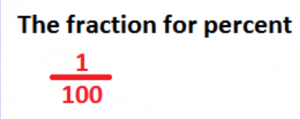What will you learn in this lesson on Percentages? Percent means per hundred. (Cent means hundred). Per cent (or percentage) is denoted by the symbol %. The fraction 1/100 is written for percent.

Percentage affords clarity and comparison.
Example:
A rebate of ![]() 40 is 20%, while a rebate of
40 is 20%, while a rebate of ![]() 60 in another shop results in 16.66%. A greater amount of discount is actually a smaller percent of discount. Sometimes, it is just a relative figure.
60 in another shop results in 16.66%. A greater amount of discount is actually a smaller percent of discount. Sometimes, it is just a relative figure.
Example:
John got 20% hike in his salary and Tom, 10% hike. Evidently enough, we cannot conclude John was blessed with a greater amount of hike, unless the actual bases, i.e. the salaries of the two, are available to us. Or, if you wish to capture a terse overview of each Percentages Formula, then go through each of the following header-links. Or, you may as well click on the following header-links to take you to the page discussing in detail the specific Percentages concept:
Converting percent into fraction. Multiply the given number with the fraction 1/100, which denotes the percent symbol %.
50% = 50 × (1/100) = ½
Converting fraction into percent. Multiply the given fraction with 100 and write the percent symbol % – (½) × 100 = 50%
Question:
A boy is 150 cms tall. Next year, he grew to 160 cms tall. What is the percent increase in his height?
Answer:
Growth in height is 10 cms on an initial height of 150 cms. So, percent growth is (10/150) × 100% = 6.67%. Percent Decrease.
Question:
A girl weighs 60 kg. After an exercise regimen, she weighs 55 kg 3 months later. What is the percent decreasein her weight?
Answer:
Decrease in weight is 5 kg on an initial weight of 60 kg. So, percent decrease in weight is (5/60) × 100% = 8.33%. Percent more.
Example:
A same book costs ![]() 20 in another shop. By what percent is the price of the book in the first shop more than that in the second shop?
20 in another shop. By what percent is the price of the book in the first shop more than that in the second shop?
Answer:
The price in the first shop is 5 more than 20 in the second shop. 5 more on 20 is how much more on 100 (i.e. percent more) 0.25
Remember the % more formula as below:

Percent less
Example:
Two boys are 160 and 150 cms tall. How much percent is second shorter than the first?
Answer:
The second is 10 cms less than 160 (height of the first). 10 less than 160 is how much less on 100 (percent). Remember the following formula for % less

Overall percent change during successive percent changes:
Question:
A stock increases by 20% in 3 months. On this price, it again increases by another 10% the next month. What is overall percent increase in the stock price which is a single value equivalent of the two successive percentage increases?
Answer:
Let original price be $100. Price after the first increase of 20% on this 100 = 120. Now 10% increase on 120 is 12. Price after the second increase of 10% on this 120 = 120 +12 = 13 2. So, 100 increased to 132 results in a 32% increase. Apply the following formula to find overall % change during successive % changes: (x + y + xy/100)%
In the given question, x = 20% and y = 10%. Therefore, the overall percent increase is [20 + 10 + (20 × 10)/100]% = 32%.